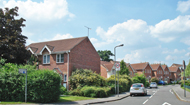Infectious diseases. Later, general, then geriatric
The Barnet Infectious Diseases Hospital opened in Mays Lane in 1907, caring for patients with diphtheria and scarlet fever.
The Hospital had an observation ward with 8 beds and two wards of 4 beds each. It was managed by a Hospital Committee consisting of four representatives from the Barnet Urban District Council, six from the East Barnet Valley Urban District Council and two from the Barnet Rural District Council.
In 1917 its name was changed to the rather unwieldly Barnet Rural District and Urban District and East Barnet Valley Urban District Isolation Hospital.
In 1938 extensions were added to the Hospital. They were officially opened in October by Sir Joseph Priestly, the Chairman of Hertfordshire County Council, and subsequently dedicated by the Revd P.C. Dean, the Rector of Chipping Barnet.
The new one-storey buildings, painted internally in a soft green, contained new wards, administration offices, a laundry with up-to-date equipment and an extension to the Nurses' Home.
The new wards were designed for isolation cases. One consisted of 10 cubicles partitioned from each other by glass panelling, so that all the patients could be kept under observation at the same time from the service room at the end of the ward. In this way, patients with, for example, diphtheria or scarlet fever could be nursed with a minimum of contact with others. The general wards were different; patients suffering from the same infections were nursed normally. A small ward at the end of each general ward was for patients who had been discharged; after bathing and disinfection they were required to remain there for 24 hours before returning home.
The nurses' bedrooms were simply furnished and enhanced with bedspreads and pretty chintz curtains. Each had electric lighting over the bed with a convenient switch, wash-basins with hot and cold water, and a little safe where valuables and money could be locked away.
The Hospital mortuary (or "viewing room", as it was called) contained a bed, which was screened off by glass because of the potential danger of infection.
The kitchen, run by a "lady chef", was equipped with an Aga cooking stove, an initially expensive investment, but which cost only 3d (just over 1p) a day to run.
By the outbreak of WW2 in 1939, the Hospital had 60 beds.
The introduction of penicillin and sulphonamide drugs in the 1940s for the treatment of infectious diseases rendered isolation hospitals obsolete and economically unviable. The Hospital closed on the introduction of the NHS in 1948.
However, the newly-formed Barnet Group Hospital Management Committee took over the empty premises in 1948 for use as an annexe to the Wellhouse Hospital. The Committee renamed the building St Stephen's Hospital, after the local church.
In 1949, when the Victoria Cottage Hospital became the maternity unit for the Wellhouse Hospital, its staff were transferred to St Stephen's.
In April 1949 a cubicle block with 16 beds for ear, nose and throat (ENT) patients opened and, in August, wards with 24 beds for general medical cases and post-operative female patients from Wellhouse Hospital. Wards were also converted for use by 36 long-stay elderly male patients, who were transferred from Wellhouse Hospital. In November a ward with 12 beds opened for general practitioner patients. The Hospital then had 88 beds, with an average occupancy of 70 (compared with an average occupancy of 10 out of 60 when it was an isolation hospital). In March 1951 beds for ophthalmic patients were made available.
By 1962 the Hospital still had 88 beds - 36 for the chronic sick, 26 for general cases, 16 for ENT and 10 for GP patients. Plans were made to extend the geriatric accommodation.
In 1966 the Hospital had 94 beds and, in 1974, 118 beds for mainly long-stay patients.
By the 1980s government health policy changed and, to save money within the NHS, it was decided to do away with geriatric hospitals. The local authorities, through their social workers, were given the role of placing elderly people in residential nursing homes.
The Hospital closed in 1989.
Present status (June 2008)
The Hospital was demolished in 1999. The site is now occupied by a housing estate - Darlands Drive.


Darlands Drive.
(Author unstated) 1938 Opening of new buildings at Barnet Isolation Hospital. British Journal of Nursing (October), 271.
www.barnet.gov.uk (1)
www.barnet.gov.uk (2)
www.bhfriends.co.uk
www.british-history.ac.uk
Return to home page